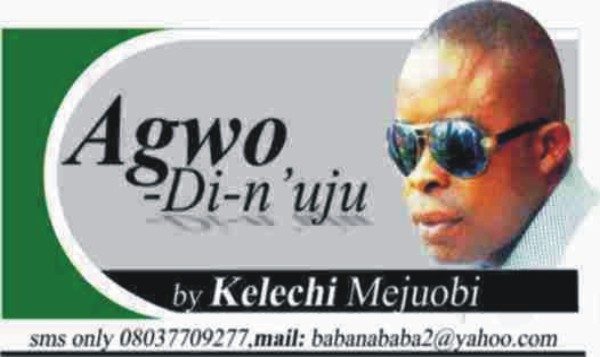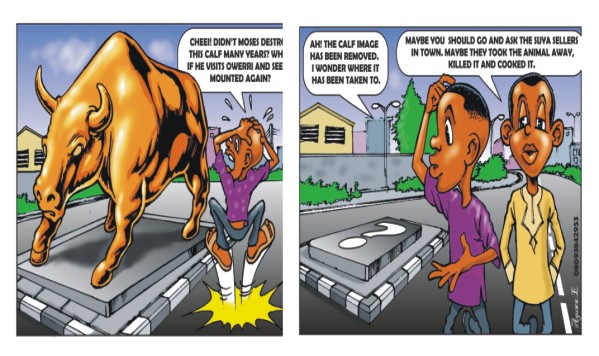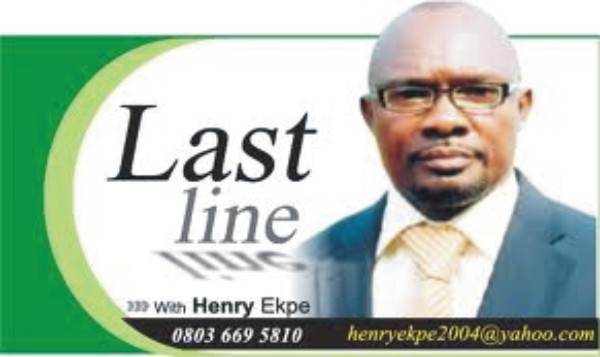It was former Nigeria’s international footballer and prolific scorer, Daniel Amokachie that reminds me about the animal called Bull. During his plying days when he donned the green and white colours of the national teams, Amokachie was fondly called Da Bull by his numerous fans and admirers. The name Da Bull originated from Belgium where he plied he first plied his trade as a professional soccer star after a brief stint with the local side Rancher Bees of Kaduna. I stand to be corrected on reasons why Amokachie’s trademark is Da Bull. But the Bull identity cannot be separated from the manner the dark-skinned ex-international charged at defenders during his active days. It would be recalled thatNigeria’s first World Cup goal was a by-product of Amokachie’s aggressiveness and fighting spirit akin to a Bull’s mode of fighting opponents. Amokachie’s Bull style led to the ferocious marking of a Bulgarian defender who lost control of the ball possession forcing the former Eagles star easily pick the ball from the fumbling Bulgaraian defender and quickly passed it over to dangling late Rashidi Yekini who wasted no time to put Nigeria’s name in the record books of World Cup goal scorers during the USA 94’ World Cup show. Even as I am not a zoo freak, the only period I got close to issues related to the Bull is on TV screen where I watched interesting Bull fighting episodes. Bull fighting is certainly one of the best-known-although at the same time most controversial-Spanish popular customs. The fiesta could not exist without the Toro Bravo, a species of bull of an ancient race that is only conserved inSpain formerly, this bull’s forbears, the primitive urus, were spread out over wide areas of the world. Many civilizations revered them; the Bull cults on the Greek tell of sacrifices of Bulls in honour of divine justices.
Going down memory lane according to historical records, Bull also played an important role in the religious ceremonies of the Liberian Tribes living inSpainprehistoric times.
Before I bore people with my “cock and bull” story, let me end the historical analysis to discuss on the appearance and abrupt disappearance of the carved Bull onWhetheral/Mbaise Road, by Fire Service Roundabout.
I heard about the Bull story but did not really get to the spot where the carved beast was stationed in Owerri until last Thursday, when some Church Pastors of the Pentecostal order informed our editorial crew that they have embarked on fast and prayers over artwork described as a “Molten Calf”. Despite the fact that the roving lens of our ace cameraman caught the picture, I was forced to drive with a friend to the spot to really confirm that the monstrous-looking object was in place. After driving around to have a vintage access and view, I merely laughed and kept mute believing it is a mere artwork meant for aesthetics and grandeur. However, my curiosity was raised two days later to be precise on Sunday when I went to Egbu road and found the beast missing from its stand. I was alarmed over the sudden disappearance. And that gave rise to this commentary. I was stunned by the sudden disappearance of the monstrous Bull. The unannounced manner it left the Fire Service Roundabout abode calls for concern. Reports have it that moment after Trumpeta hit the newsstands that “Church Pastors Fast Over “Molten Calf in Owerri, it was reported that concerned authorities in the state became jittery. By Saturday evening, some yet to be identified persons took over the premises where the Bull was mounted and began to remove it. By Sunday Morning a crane and truck was on ground to tow the artwork away. It would be recalled that the arrival of the Bull elicited reactions among people of the state. Divergent views had trailed the stationing of the Bull at the Fire Service Roundabout.
This is not the first time, a carved item or artwork instituted in one of the few roundabouts in the state is raising dust. Though, I was not in Imo state during the first four years of ex-Governor Achike Udenwa, when an artwork mounted at the popular Government House/Okigwe Whetheral Road Roundabout caused uproar. The artwork known as Ikenga was instituted at that spot. Spontaneous reactions heralded the Ikenga before it was subsequently removed and replaced with a cross. However, how the cross disappeared has been a subject of discussion ill date. The Udenwa government did not bother about another artwork for the roundabout as it has remained fallow until the present administration is toying with a new beautification work. The arrival of the Fire Service Bull orchestrated by the Owelle Rochas Okorocha government has again stirred controversy. Moreover, the inscription of “the strength of Imo” at the body of the removed Bull undoubtedly heightened interest and aroused curiosity. And that brings us to the issue of the relationship between Ndi Imo and Bull.
To worsen the matter, the state government or agency responsible for the installation kept the public, especially Owerri residents in the dark on the erection and dismantling of the Bull. The quiet posture maintained by state government information unit over the issue is not only an incriminating silence but a suspicious move to challenge the mental psyche of Imo people. The concerned church clerics and Owerri residents would not be troubled if the Rescue Mission government had publicly declared intention to beautify Owerri streets with beast artworks. And that “charging Bulls” would be the most appropriate for the roundabout. While informing the public of the decision to station Bulls at strategic points in the states capital, the present administration would have also given reasons for the choice of a Bull. Communication between the governed and government is a veritable tool for any successful civilian administration in a democratic set up. It will be fool hardy for any government to keep the citizenry in the dark about its policies as that could be catastrophic. Since democracy simply translates to government of the people, for the people and by the people, the public needs to be aware of the workings of government before policy implementation.
Since the state government has not made any public pronouncement. Concerning the Bull, I have no reasons to question the morality or otherwise of mounting or dismantling of the Bull at Fire Service. But there is need to review the coming of the Bull and know if the monstrous-looking beast is most appropriate for our roundabouts as I was reliably informed that three of such animal were on ground to take their positions before the public outcry and subsequent removal. For instance, Abathe commercial nerve centre of AbiaStateis synonymous with Enyi (Elephant) as people of the area are known for their Nsogwu-Nsogwu, Enyi Mba Enyi slogan. It will not be an anathema to see elephant structure in any part of Aba. Is the Bull synonymous with Ndi Imo or Ndi Owerre? Artworks to be stationed at strategic places in the state capital should be structures that reflect culture; which is the way of the people or things in tandem with the socio-cultural, economic life style of the people; does the “Fire Service Bull” reflect any of the aforementioned issues? How does a charging Bull reflect the strength of Imolites? Who said that and who did they consult before branding a bloody beats our strength? Owerri people and indeed Imo citizens are unique people and deserve unique attributes that are in contrast to the Bull structure. Nobody would have raised eyebrows or gone into prayer and fast had it been that the sculpture of one of our revered leaders and former Governor, late Chief Sam Onunaka Mbakwe was moulded and installed at the Fire Service Roundabout as Chief Michael Okpara of blessed memory adorns a roundabout in Umuahia, the state capital. Since Owerri is noted for Bongo and highlife music, a satirical Bongo musician of Owerri descent or better still, the Oriental Brothers leader and popular highlife music maestro, late Dr. Sir Warrior would have been better. If those in charge would reserve the Control Post Roundabout for items that a familiar with Christianity and God because of the presence of Assumpta Cathedral within the vicinity, the sculpture of Ekwema Arugo, the historic founder and father of Nde Owerre would also have been better at least to pacify the Owerre people who march through the Fire Service to Ugwu Ekwema for their annual Oru Owerre festival and for allowing the state capital be in their domain. Also, since palm tree, palm wine, yam, cassava and other staple foods are some of our local agricultural products, an artwork of a palm wine taper, palm tree cutter or farmer tilling the soil would have also been better if placed at the roundabout. As predominant Christians, we draw our strength from God and not beasts. It was our fore fathers who worshipped idols and had such beliefs. It is also ironical that while the Catholics are celebrating the Centenary or 100 years of Catholic Church in Owerri, we are getting our strength from a Bull rather than the image of Christ.
On my next and final question; where is the Bull, where has it been taking and who is in custody of the art work? Is there any purpose behind the appearance and sudden disappearance at a popular roundabout in the state? Imo people expect to get the response and the people concerned should talk and explain issues before tongues begin to wag again over the development.











